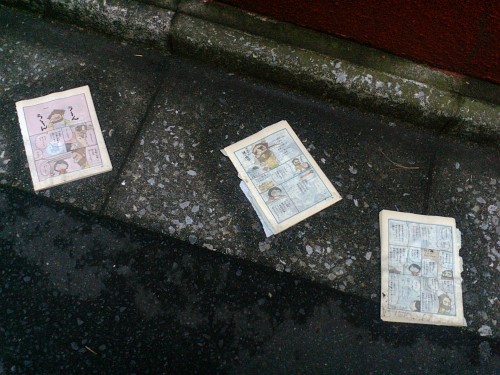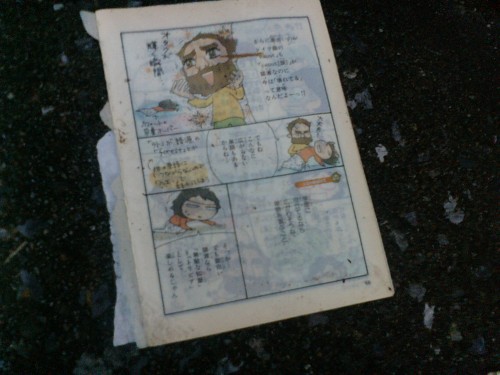I came across this depressingly soggy ex-manga on the road near my apartment:
This was a volume in the ダーリンは外国人 series (Literally translates as My Darling is a Foreigner but has been sold in English translation under the godawful title Is He Turning Japanese? Out of basic respect for human dignity I will use the literal translation in this post).
Whoever left this must really have not liked what they read since it looks like they took the effort of tearing the the binding apart into three pieces before leaving it to rot. I’ve read the first two volumes (one of Mrs. Adamu’s friends gave them to us as a gift appropriate for our situation), and while they weren’t my favorite they don’t deserve this level of disrespect.
But I always believe that when life gives you soggy manga on the street, you use that opportunity to write a review of that manga in the hope that something constructive can come out of such a senseless waste:
Adamu’s thoughts on My Darling is Foreigner
The series, a semi-autobiographical episodic story of the daily life of the author, a Japanese woman with no international experience or English ability, and her quirky, multilingual American husband, was a surprise hit in Japan. According to an undated article at the Hiragana Times, the first volume has had at least 28 print runs since the first edition hit bookshelves in 2002.
I might expect too much from a manga that wears its light-heartedness on its sleeve, but this title was a letdown when I read it a few years back. As a manga it is very well-drawn (I was especially impressed with the detailed closeups of Tony’s face), but the depiction of main character Tony (pictured above) leans too heavily toward a two-dimensional “Hello Kitty” caricature, someone who hasn’t got a personality so much as a list of quirky but endearing distinguishing traits (extremely obsessed with learning languages, generally kind-hearted but won’t change his mind once he’s settled on a decision, doesn’t like to be told how to wash the dishes out of a sense of respect for individuality, has deep-set eyes).
While Darling was basically very well-received by a public that’s used to being entertained by exotic-looking foreigners who love Japan and can speak their language, the manga was not without its detractors. Critical Amazon commenters, many of whom claimed to be in international relationships and to have received the manga from well-meaning friends, seemed turned off by the superficial observations and general dullness of confusing the routine aspects of married life with a deep commentary on international marriage just because the husband has a white face and commutes to Starbucks. Some speculated that the author’s lack of English ability and experience abroad led her to concentrate on the superficial aspects of Tony and fall short of all but the most amateurish insights. Interestingly, some pointed out that Tony seems far more integrated with Japanese society than your typical foreigner, while others got the impression that he’s just a miser who couldn’t fit in back home.
I felt a little disappointed to see a person reduced to such simplicity in the name of keepin’ it honobono, especially since the title implies he represents “foreigners.” And I want to emphasize that Tony is in no way typical of the American population here. Some of Tony’s quirks – as seen in episodes where he badgers a pizza place into letting him use expired coupons and demands a waiter give them wine free of charge since he didn’t like how it tasted – are downright abrasive and share more in common with the stereotypical obatarian than an American man, let alone “foreigners,” which as a term is far too broad (though it fits in with the Japanese connotation of gaikokujin to mean a white Westerner first and foremost). More than any of that, however, I found it hard to stay interested in want of any compelling characters or really any story elements more complicated than your typical episode of Sazae-san.
Still I don’t see any reason to disrespect a perfectly good manga, especially when there is a used book store just a few hundred meters away.
Continue reading “My Darling is a Foreigner” Manga disrespected in Ayase



 As it so happens, just last week I picked up
As it so happens, just last week I picked up